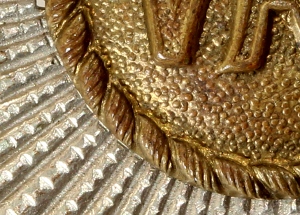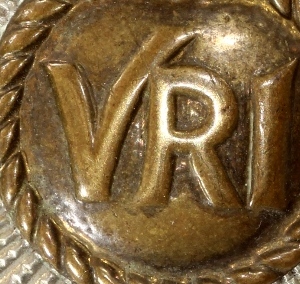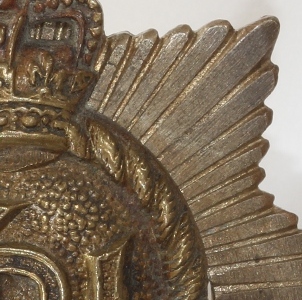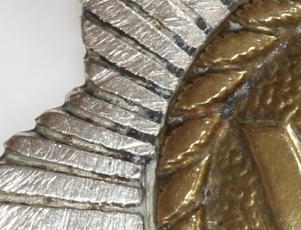Topic: Militaria

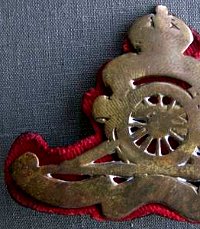 In some regiments it was preferred to have a central part of their badge noticeably "domed" and long and nerve-wracking moments using the open end of a pipe (like a barracks shower drain) and a carefully dropped round-ended broom handle against the back of the badge to achieve that effect. A similar result could also be achieved by applying pressure with the hand while working the badge over the broom handle end. Poster DavidS describes this technique on the British and Commonwealth Military Badge Forum:
In some regiments it was preferred to have a central part of their badge noticeably "domed" and long and nerve-wracking moments using the open end of a pipe (like a barracks shower drain) and a carefully dropped round-ended broom handle against the back of the badge to achieve that effect. A similar result could also be achieved by applying pressure with the hand while working the badge over the broom handle end. Poster DavidS describes this technique on the British and Commonwealth Military Badge Forum:
"... a 'broomstick vault'. A guy would put his badge on the end of a rod like a broom handle and give it a good smack with his palm to give it the convex shape."
A domed example of a Perth Regiment badge can be found on this page.
Soldiers also learned quickly that the smoother a badge was, the higher a shine could be achieved. In some cases extreme examples can be found where all details were removed to leave a single smooth surface in the shape of the original badge. Some extreme examples of this being dome to Artillery badges can be seen at this page. We can probably presume that the most severe examples were reserved for walking out dress, and that few soldiers would dare to appear on parade with a badge altered to such a degree.
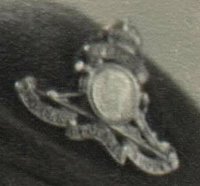 Another common alteration to the Artillery's badge was to replace the wheel with a coin, thus providing a solid surface that could be more easily polished to a high sheen. Again, polishing to remove any details of the coin's original face accentuated this effect.
Another common alteration to the Artillery's badge was to replace the wheel with a coin, thus providing a solid surface that could be more easily polished to a high sheen. Again, polishing to remove any details of the coin's original face accentuated this effect.
From poster Michael Reintjes at the British and Commonwealth Military Badge Forum we find the following comments:
"Heavily polished and altered badges have become an interest of mine for some time. I have several CAC, RCA and RCR cap badges that have been obviously intentionally altered by the owners and one with provenance. An RCR cap badge that was given to me by my next door neighbour ... intentionally polished on a wheel by the soldier and he told me this was common practice among his peers as well."
"As Bill says alot of these were done on wheels as they were not in use long enough to be worn down during polishing."
"Artillery and CAC cap badges seem to be some of the favourites of the polishing wheel treatment. The CAC Badges are very selectively done with the details of the tank being polished with the rest of the badge left alone. I even have one with the tank polished smooth and the words RECCE T.C. engraved on the tank. The arty badges also seem to be a favourite one with heavy polishing and even several I've seen with a Dutch or Italian coin sweated onto the wheel of the gun. The most common RCR alteration seems to be to grind the rays of the star completely flat and then polish to a mirror finish like the one I got from my neighbour in the 70's."
"I've stopped looking at them as damaged badges and see them as actual theatre worn artifacts which of course they are and to me anyway mean more than the bags of mint ersatz unissued examples that sat well into the 60's at the RCOC depot in London or Borden."
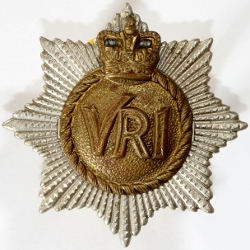 As noted, not even The Royal Canadian Regiment was exempt from soldiers trying to improve the appearance of their badges to obtain a better surface to shine. There are two basic modifications that can be found on older regimental badges to achieve this. The first method was using the point of a bullet to burnish smooth the pebbling around the central "VRI" of the badge frontpiece.
As noted, not even The Royal Canadian Regiment was exempt from soldiers trying to improve the appearance of their badges to obtain a better surface to shine. There are two basic modifications that can be found on older regimental badges to achieve this. The first method was using the point of a bullet to burnish smooth the pebbling around the central "VRI" of the badge frontpiece.
The second required a little more work and the right tools as described above. This technique resulted in the smoothing the diamond cut pattern of the badge star to leave an smooth a surface as possible that would shine easily and reflect the light better than the broken surface of the original pattern of concentric circle and ray divisions. This technique could also be extended to smoothing the tops of the edges of the "VRI" lettering.
|
|
|
|
